NEW ORLEANS
October 31, 2014
STRANGER: Brobson Lutz
LOCATION: Galatoire’s Restaurant, 209 Bourbon Street, New Orleans
THEME: Dining with a long-time French Quarter doctor
One minute into dinner with Dr. Brobson Lutz, and I’d already erred.
“If you take your jacket off, the waiter will make you put it right back on,” said Brobson with a grin and conspiratorial whisper as I sat down to a table at Galatoire’s Restaurant. It’s a classy place, one of the oldest restaurants in New Orleans’ French Quarter. The waiters wear tuxes and bow ties, and the gentlemen are required to keep their jackets on at dinner.
So I halted my slow removal of my suit jacket and pulled it back on tight.
Brobson, decked out in a dark suit and tie, grinned again. He knows how it works at Galatoire’s. He’s been coming here for decades, and has lived in the Quarter a similar amount of time in a sprawling house a dozen or so blocks away from Galatoire’s. Behind his orange-rimmed circular glasses, his eyes can spot who’s a local and who’s a tourist based just off a passing glance.
“Oh, they’re definitely tourists,” he said as he watched a small group of diners being led to the upstairs dining room. “Never eat upstairs. That’s where they stick the out-of-towners, Anthony,” he said, chuckling.
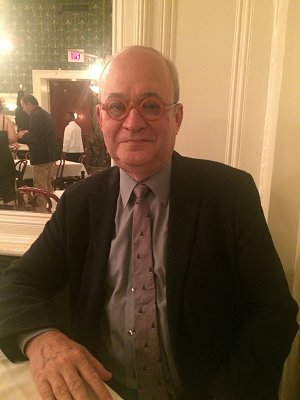
Brobson, 67, was raised in Alabama, and his Southern drawl is strong. He pronounced my name Ant-knee, while other words further gave away his heritage: cane-t for can’t, and turning Louisiana into something akin to Loos-e-anya. I was with a true Southerner at one of the South’s oldest eateries.
We were downstairs at a prime spot: the exact same table that Tennessee Williams favored whenever he would eat at Galatoire’s. It’s in the corner of the dining room, next to the massive window that looks out on to Bourbon Street but is covered with a white cloth curtain. The window used to be the main entrance, and Williams would “sit here and drink himself into oblivion,” said Brobson.
The table was a perfect vantage spot to watch over the whole room, which features black-and-white tiled floors, green wallpaper and mirrors all around. I’d heard that reservations for Galatoire’s downstairs are not allowed, especially for a visitor from another city. So it was telling that Brobson could secure the table at precisely 6pm on a Friday night, even as others waited to be seated. After witnessing the waiters and maître d’ treat him like an old friend, I understood why.
“Ah! Here’s Casey, he’ll take care of us,” said Brobson, waiving to his waiter. Casey serves on the doctor every time they’re both at the restaurant. The way it works in the Big Easy’s old-school restaurants is that you have a dedicated waiter who gets to know you and your likes. We weren’t even offered menus. In fact, they both laughed when I asked for one.
“You won’t be needing a menu,” said Brobson, winking at Casey.
“And if you have any questions, ask this guy,” replied Casey with a grin.
They guided me through the order, listing what seemed like a mountain of food. Then Casey left us with some sazeracs. Considered to be among the first cocktails invited in the United States, a sazerac is a whisky-based drink with absinthe and bitters, and has a pleasant tang.
I sipped, and chatted with Brobson. For more than two hours, he regaled me with stories of his childhood in Alabama and moving to the Crescent City, enduring Hurricane Katrina, being a doctor, loving life, and more.
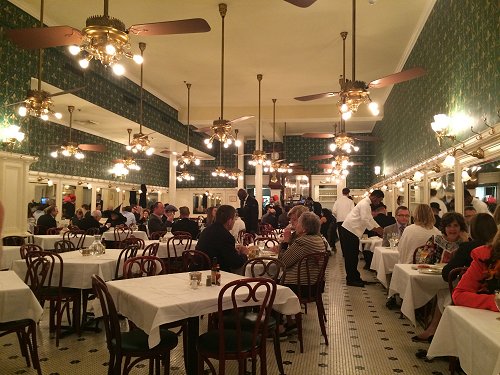
I first read about Brobson in a graphic novel, A.D.: After the Deluge. The book is a collection of stories about residents’ experiences during Katrina, including the doctor’s experiences staying in his French Quarter home.
Brobson was contacted by Larry Smith, who runs the online Smith Magazine, to see if he would share his story of the storm with cartoonist and illustrator Josh Neufeld. He agreed, and the end result is one of several memorable stories that make up the book. “I’d never read a cartoon book before,” said Brobson. But he was impressed with the end result and its tales of a city deluged.
New Orleans is a city that is at or below sea level depending on the neighborhood. Brobson’s French Quarter home is on some of the highest ground in the low-lying city. So he decided to ride out the storm from his home, refusing to leave the city. And he was fine. Compared to the lower ninth ward and other parts of the city, the French Quarter escaped the storm relatively unharmed.
“You know, if I lived on the coast, I wouldn’t have stayed. But the building I live in has been up since about 1835. It’s seen every hurricane that’s come, so I stayed,” he said.
Remaining in the Crescent City also meant that Brobson was able to monitor his property — things like knowing when the winds blew open doors or broke windows. “One of my doors blew open, and if I hadn’t been there to shut it, you don’t know what could have happened.”
Brobson’s usually lively nature turned quieter when he talked more about the storm. He recognizes that he was fortunate to have lived through it with only minor, temporary inconveniences like a few days with no running water. Whole neighborhoods elsewhere in the city were wiped out after the levees failed following the storm, flooding those areas.
“It wasn’t the hurricane that did it. It was the levees breaking. Streets were washed out till all you could see was the foundations of houses. Whole communities are gone. There’s maybe one person living on some blocks now. We lost a lot of good people,” said Brobson, his eyes watering. He dabbed at them with his napkin, then looked down at the table for a few moments.
Then he got a twinkle in his eye, and revved back to his uproarious self.
“But we have a lot of wonderful, hard-working people still here,” he said, smiling.
Some of the city’s hard workers include Galatoire staffers who returned after Katrina, Brobson said. Among the waitstaff, we got a great server with Casey.
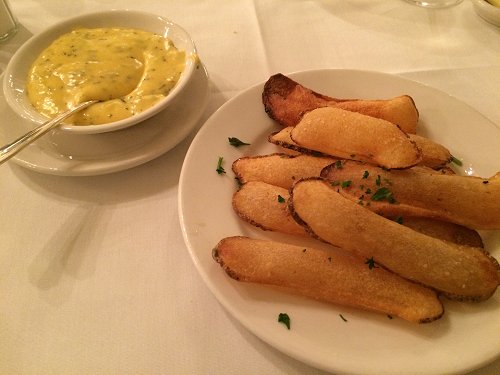
He came back to the table armed with more drinks (another sazerac for me, white wine for the doctor) and an appetizer of souffle potatoes with a dish of Béarnaise sauce.
They’re fried potatoes puffed up so that they’re full of air. Salted lightly on the outside, these rectangular snacks are crisp and irresistible. Galatoire’s makes a thick, flavorful Béarnaise that’s excellent for dipping the potatoes in before each bite.
As we worked through the stack of potatoes, I asked Brobson how he came to earn the great service that I’d already witnessed. He replied that Galatoire’s is one of his favorite restaurants in the city because of the friendly and knowledgeable waitstaff, the drinks (they’re strong and well-made) and the atmosphere in the downstairs dining area, which is dominated by locals.
“You come here a couple of times a month and you get to know the people,” he said, munching on a souffle potato. “They take care of their repeat locals here.”
During his decades in New Orleans — including serving as the city’s public health director — Brobson has earned the moniker of local. But he’s not from the Big Easy originally.
He was born in South New Jersey but hardly spent any time there, being raised in Athens, Alabama. “That’s where I learned to talk,” he said, drawling the last word out as taw-k. “It’s a classic deep South accent. It’s not a New Orleans accent at all. The native people down here talk like the Brooklyn shipyard people.”
Alabama was a “backward” state when Brobson grew up there, he said, noting that segregationist George Wallace was governor at the time. “When I left Alabama, it was probably the most backward state in the nation. Louisiana was actually one of the more progressive states in the South at that time. So I come down here, and now Louisiana has turned conservative. It’s almost like I can move and destroy a state! My power scares me!” he said, bursting into laughter.
He’d always had an interest in genetics, science and math, and medicine seemed liked a good fit for his college studies. Originally he thought about being a veterinarian, but quickly passed on that idea because of the overwhelming tasks that vets have to do: everything from diagnosis to operations and cleanup after the animals. “I couldn’t handle all the chicken shit,” he said.
Another thing that the doctor can’t handle, or won’t tolerate, is bad seafood, I’d learn. But thankfully Galatoire’s excelled with its seafood starter that night.
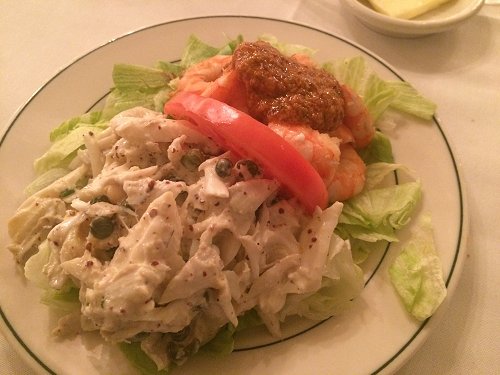
Casey returned with a plate divided half between shrimp with remoulade sauce and the other half a crabmeat ravigote. To my untrained eye, they look glorious.
“Crabmeat good tonight?” Brobson asked Casey.
“Yeah,” came the reply, with a smile.
Good enough for Brobson. He dived in, and I followed his lead. The thick, succulent shreds of crabmeat were coated in a delicious ravigote sauce of capers, mustard, lemon juice, mayonniase and more.
“The best crabmeat is from the bayous and the brackish waters,” said Brobson. If restaurants are offering crabmeat in the winter — when it’s typically not available from Louisiana waters — he said that they instead serve up what he described as “homogenized crap” shipped in from overseas.
Not so that night. “This is perfect crabmeat and perfect shrimp. They’re taking good care of us,” said Brobson, diving into the mound of freshly peeled shrimp.
I also tried the shrimp and a dab of the remoulade sauce, and complimented the freshness of the crustaceans. “I sometimes have problems with the shrimp here. Sometimes they use this pre-peeled frozen shrimp and it’s no good” he said. “I love the waitstaff here, but I’ve become hyper-critical of some of the management. And that can be a lot of fun,” he said, grinning again.
As Brobson describes it, the bad method of preparation — used by restaurants for convenience and to cut costs — is to catch shrimp, then put them in a cement mixer with a bunch of rocks and stone their shells off. “You stone them to death just like they used to do to people in the Bible,” laughed Brobson. “But boil them and they come out like rubber.”
Great shrimp are boiled in their shell and then peeled, as they were that night at Galatoire’s. They were soft, almost melt-in-the-mouth. And the tangy remoulade sauce was a perfect complement. We ate them so quickly, pretty soon there was only one left.
“Eat that last one, Anthony,” said Brobson. I did.

While I ate, he told me that after he lost his interest in being a veterinarian, he switched his focus to human medicine. He spent a few years at Auburn University in Alabama before transferring to Vanderbilt University in Tennessee. Then eventually he enrolled at New Orleans’ Tulane University. He’d finally achieved his goal of moving to the Crescent City.
Brobson fell in love with New Orleans on a visit with some friends decades ago. His timing wasn’t the greatest, as it was in 1965, when Hurricane Betsy made landfall. “We watched the whole hurricane from the bar at our hotel,” he said. To pass the time, Brobson made wagers with the patrons that he could stand on his head and drink a whiskey sour. He won every bet.
But it wasn’t winning money on drunken bar bets that made him fall for the city. Instead, it was many things. “The spirit, the people, the foods I’d never had before, the music I’d never heard before,” said Brobson. “I knew that I needed to come to New Orleans, and that’s how I ended up at Tulane.”
He did four years of medical school followed by four years residency, specializing in infectious diseases. He was drawn to the specialty following some work experience he did at a laboratory in Maine, finding that the subject combined his love of math and genetics.
During his university studies, Brobson had also been working part-time at the city’s venereal disease clinic. After graduation, he heard the clinic needed a medical director. He got the job.
Jump forward a while, and the city was looking for a top communicable diseases official. “They were paying next to nothing, so nobody else wanted the job and it was easy to get.”
He served in that position for some time before another vacancy opened up in 1983. This time it was for a much bigger role as the director of the New Orleans Health Department. “I think I was probably the youngest director of a large city health department at that time.”
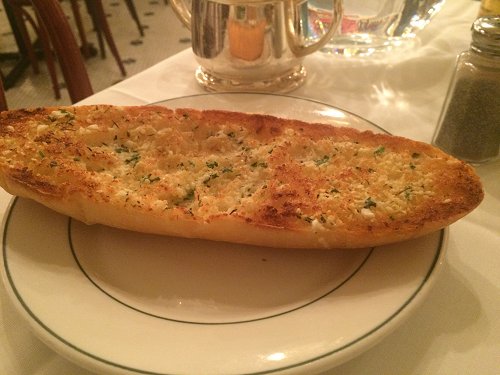
Before Brobson could elaborate on what the health director role required, Casey had returned armed with a slab of garlic bread for us to eat while we waited on our entrees.
It’s an obvious statement, but garlic bread can sometimes taste too much of the garlic. It can be off-putting to bite into the toasted loaf and end up unable to detect any other flavors except something that will drive Dracula away. It’s with relief I can report that the garlic bread at Galatoire’s is mildly flavored, a perfectly decent attempt and a hefty serving too.
I tucked in to the bread while Brobson recalled his time as city health director.
He said it required a lot of administrative work rather than hands-on practicing of medicine. It was a struggling department when he took over, with a budget of $4 million in 1980s dollars. Brobson hired a deputy, who was also a nurse. “The first thing a doctor wants is a great nurse. But she was also a master at getting grants,” he said. By the time he left the department the budget had skyrocketed up to $60 million. It’s since plummeted back down, he said, sighing.
One thing he’s proud of overseeing as director is the creation of an administrative adjudicative hearing process for violations of environmental laws and regulations. He presided over more than 2,000 cases — in only a handful of the cases were the accused found not guilty. “It was swift justice like in the Old West,” he laughed. “I went to medical school and came out of work a judge.”
Brobson also oversaw an expansion of the city’s public health clinics, and said New Orleans during his tenure had one of the highest rates of immunization for children.
During his time as director he also learned a thing or two about the government budget process and how to score more money for the health department. When he knew a budget hearing was coming up, he’d take his staff and an STD testing van into a housing project and tests hundreds of people. From 200 residents tested, they’d end up showing at least a dozen new cases of syphilis. “Then we could announce an epidemic, and go ask for a bigger budget a week later,” he said.
Again he laughed out loud as he reminisced, with a gleeful chuckle that makes it impossible not to laugh along. The only thing that made us regain composure was Casey’s return.
Once again our faultless waiter was armed with plates full of food.
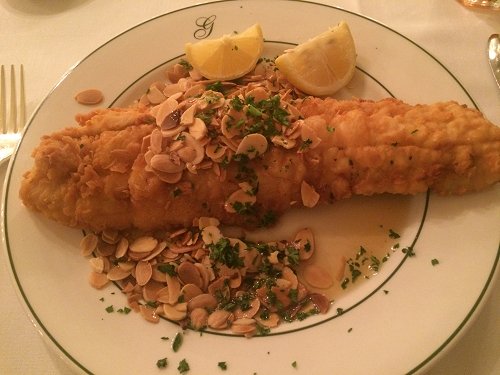
At the suggestion of both Brobson and Casey, I went for the trout amandine. Lightly battered trout, drizzled with melted brown butter and lemon and topped off with toasted almonds. The fish was thick and meaty; the batter perfectly crisp. I’ve got a sweet tooth, so couldn’t get enough of the sauce and the almonds. There was nothing else on the plate, and that would have been enough.
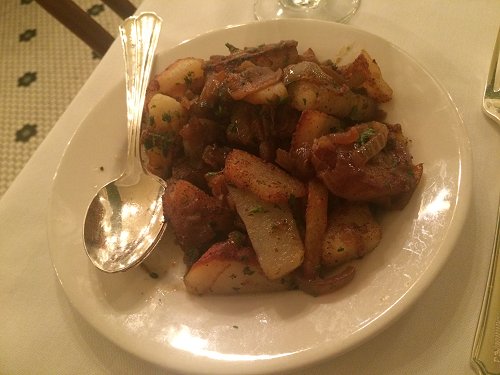
But we also ordered a side of Lyonnaise potatoes, which is a heap of sliced potatoes slathered with chopped onions and a sprinkling of garlic and parsley. Great stuff.
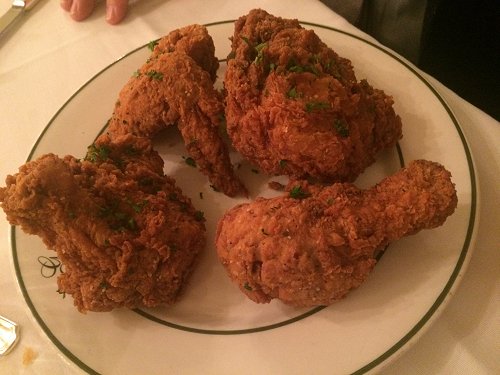
Brobson went off-menu for his entree, ordering fried chicken. “This is the best dish in the house, they have it back in the kitchen but not many people know that,” he said.
He ordered sauteed spinach to complement his entree, and I gave that and the chicken a taste. It was a great combination, but I had more than enough food with the trout.
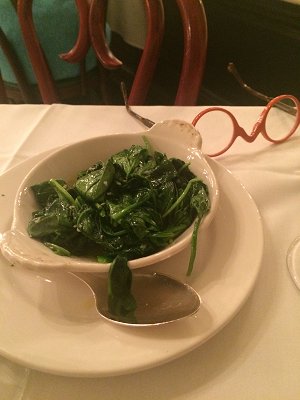
While we ate, Brobson said though he enjoyed working at the health department, he’s done with the public sector for good. He left the department after 13 years of service. “That’s something that’s important for people to do when they’re young, energetic and idealistic. They can put up with the bullshit,” he said.
He knew it was time to step down when he stopped getting the resources he needed. The health director gig was a mayoral appointment and Brobson was routinely reappointed across several administrations. Yet after Mayor Marc Morial was inaugurated in 1994, Brobson saw the exit door opening. He said the two never clicked, and for the first time red tape was being wrapped around the department. “It got to where if we needed $50 worth of paper, the only way we could get it was if I personally requested it. It wasn’t fun anymore.”
Nowadays he has his own practice in the city’s Uptown neighborhood with his partner — and fellow doctor — Kenneth Combs. Brobson is still specializing in infectious diseases. He also makes appearances on the local WVUE television station giving out information on all manner of health topics, ranging from Ebola to joint stiffness.
“I think the dissemination of health information in a form that people can understand is very important. I grew up in Alabama, where we understand simple things. I can put some of these medical things on a level that people can understand. Part of it is public health education, part is trying to bring common sense to medicine. There’s a lot of low-value medicine out there, and such unnecessary testing being done,” he said, shaking his head.

For example, some of his patients might rush to the emergency room for something as innocuous as a sort throat. They’ll end up with x-rays and consultations and leave with a bill for thousands of dollars. “I could have treated that with a $20 prescription for antibiotics,” said Brobson. He said the problem is only getting worse as new testing technology becomes available, and money-minded doctors look to earn more cash.
Our topic wandered onto other health topics, including the biggest threat to public health he’s ever seen. “It’s Republican politics!” he said with a laugh, rocking back in his chair.
When he regained composure, he said that he actually believes obesity is the biggest health threat facing the United States. “Hands down,” he said. “Obesity in the South kills more people than anything else. It’s our biggest problem because of fast food restaurants. The more somebody messes with your food, the more likely it is to make you gain weight. The more it’s processed, the more it goes right here,” he said, patting his stomach.
He smiled again as he put down his knife and fork. “When I came to New Orleans I had a 28 inch waist. I could buy my clothes in the boy’s department. Now it’s 38 inches,” he said.
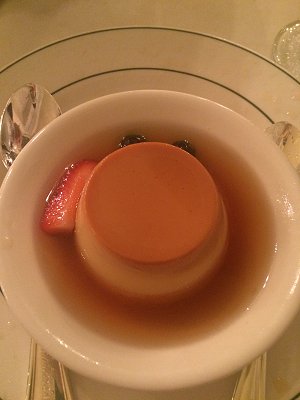
Dining at Galatoire’s could be one of the culprits. I was already full, but it was impossible to resist the urge to keep on eating as Casey brought out a caramel custard for dessert.
Light, ladled in syrup, and sweet, it was a nice way to top off dinner.
Brobson declined a spoonful, leaving me to finish it off while he leaned in to share stories about some of the remarkable scenes he’s witnessed as a Galatoire’s regular.
Take the saga of Gilberto Eyzaguirre. He was a beloved waiter at the restaurant who worked there for more than 20 years. But he had one flaw. Allegedly he had quite a penchant for pinching the posteriors of the female waitstaff. The management kept cautioning him until one day they’d had enough and fired Gilberto. This triggered outcry from his regulars, and a campaign was launched to reinstate him. It was extensive. A website, We Love Gilberto, was launched; a play was written and staged; letters were written to the Times-Picayune newspaper.
Brobson was a fan of Gilberto’s fine service and attention to detail, and was part of the campaign to reinstate him. Gilberto eventually sued the restaurant claiming wrongful termination for not investigating the complaint that led to his firing, but he eventually settled. Brobson said the settlement value wasn’t disclosed, but that it meant Gilberto could never work at Galatoire’s again.
“Through that whole experience, I really got to know the employees here even better. I don’t get along very well with the management but I do with the employees,” Brobson said.
It’s through the waiters he heard the story of the time the “Tips For Jesus” guy was in the house. He’s a mystery diner — said to be former PayPal Vice President Jack Selby — who leaves massive tips at restaurants. Apparently, he left a $10,000 tip on his $9,000 meal at Galatoire’s (and there’s a photo of the receipt on Instagram). The meal was so expensive, Brobson said, because the mystery gourmand ordered expensive bottles of champagne for all the other patrons in the downstairs dining room.

That same night, fueled by alcohol, a large, muscular man that was with the mystery diner stood up and challenged everyone to an arm wrestling match. The victor would get $1,000. One of Galatoire’s managers volunteered, but was not strong enough — and got a fractured arm in the process.
Brobson took that story and put it to good use, as he writes a monthly health column in New Orleans Magazine. He wrote one article all about fractures of the arm.
Another story he told was the time a drunk high school student from a Catholic high school decided to take a bathroom break at the table. He started urinating, and a maître d’ ran over to stop him. He grabbed the student from behind, but they fought, and the kid span around. “He was helicopter peeing all over the place,” said Brobson, guffawing at the memory. “The next day we all came back wearing yellow raincoats. This place is dangerous! You can get peed on, or your arm broken!”
“You never know what’s going to happen,” said Casey with a grin as he returned.
Our waiter then set down a massive steel bowl on the table to prepare Cafe Brulot.
It’s an intoxicating mix of strong black coffee, cloves, cinnamon, and peel from oranges and lemons. The bowl is lit on fire at the table, and the combinations rapidly heat until the drink is ready to serve. To top it off, waiters will sometimes do a little pyrotechnic show by igniting a strip of peel or dousing part of the table in still-flaming mixture.
After being wowed by Casey’s demonstration — and avoiding being singed by the flames — I sipped on the unique flavor of Cafe Brulot, which has the bitterness of coffee but other sweet and citrus tastes. It was so good I couldn’t resist several cups.
“This is a signature drink of Galatoire’s,” said Brobson.
As I sipped, Brobson said he became much more interested in food since moving to New Orleans. He’s sampled the wide range of culinary and beverage choices that the city has to offer, and expanded his knowledge accordingly. And he’ll work for his supper for dishes he really likes. He even raised a number of squabs (a young pigeon) for eating after finding out that restaurants had stopped serving them. Brobson would bring his squabs to his favorite places to have them cooked.
It’s a request I’m sure Casey would grant in a heartbeat if Brobson asked. The two had a natural, friendly chemistry far beyond the familiar way that waiters treat all customers. “The locals all have their own waiters, because this is a very waiter-centric restaurant,” said Brobson. “I think that upsets the management because they want people to come for the Galatoire’s experience, not the waiter. But it’s through the waiter that you find out everything that’s going on.”
The goings-on include the stories like the big tipper, like Gilberto the waiter, like the arm wrestling, like the helicopter pee spray, which keep Brobson entertained whenever he dines at Galatoire’s.
The hilarity and unexpectedness of those types of tales fit into the reason why Brobson fell in love with the Big Easy in the first place — and why he still adores the city. “This is a city for living in the now,” he said. “Back in the 1800s, New Orleans would have yellow fever and it’d wipe out 20 percent of the city. Same thing happened during Katrina. Suddenly 20 percent of our population was gone.”
He paused. His lower lip quivered slightly.
“You live differently in a city like that,” he said. Then his eyes watered again, and once more he sat silently for a moment. “We just have the greatest people in New Orleans.”
So great to get this update on A.D.’s “The Doctor” and hear more of his life story — as well as those great tales of Galatoire’s! Back in 2007 when I was interviewing Brobson for A.D., the Gilberto controversy was still in full furor. Brobson always loved to gossip, and I’m happy to see that hasn’t changed! Really enjoyed this rundown of a classic NOLA meal.
Oddly enough, my wife and I (both from Alabama) met Dr. Lutz in the dinning car aboard a train bound for New York city last year (2018). He introduced himself and talk with us as if he’d known us for years. He’s a great southern gentleman and wonderful conversationalist. Awesome job on this article. Thanks
9yfook
0etlr2